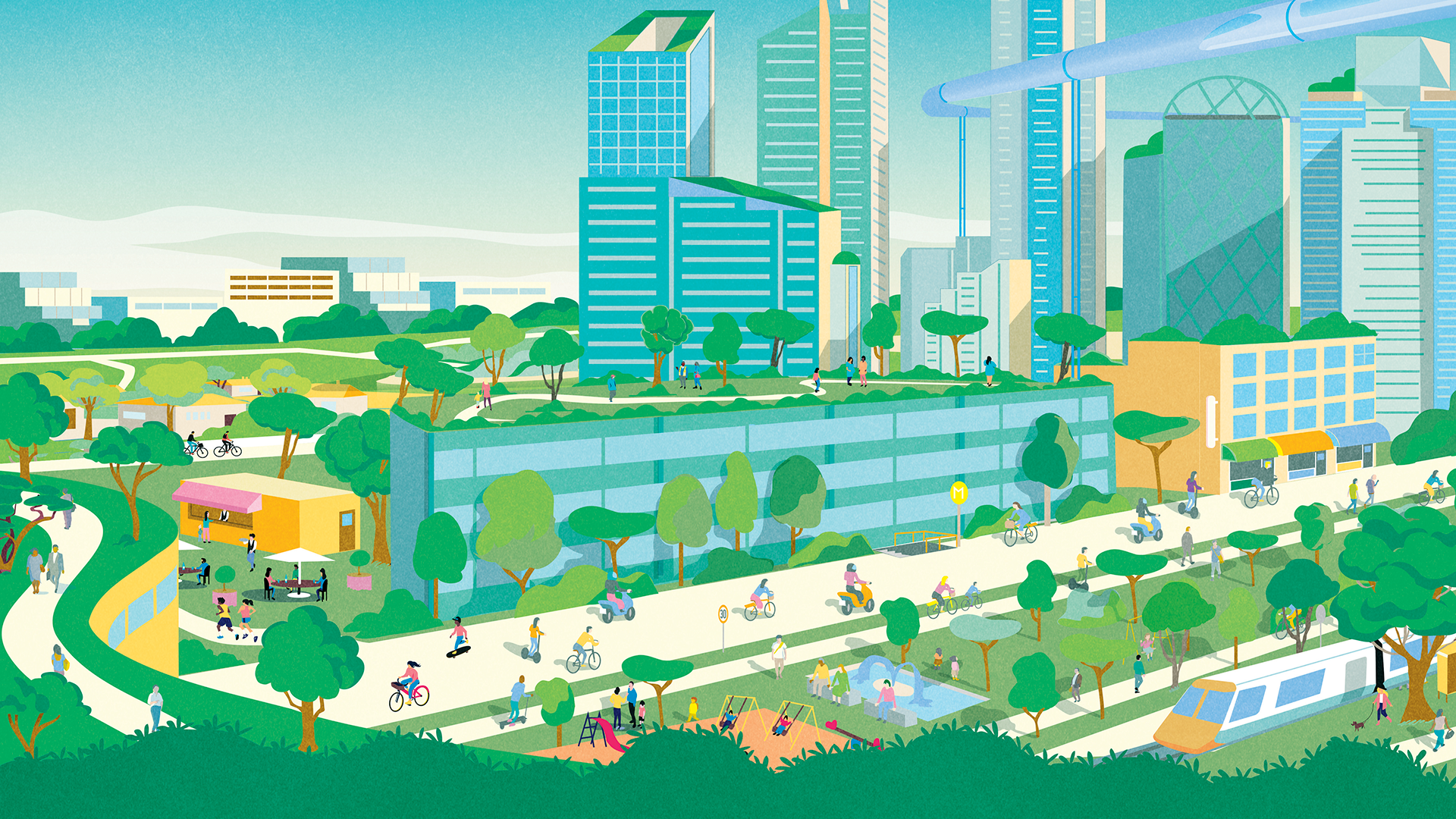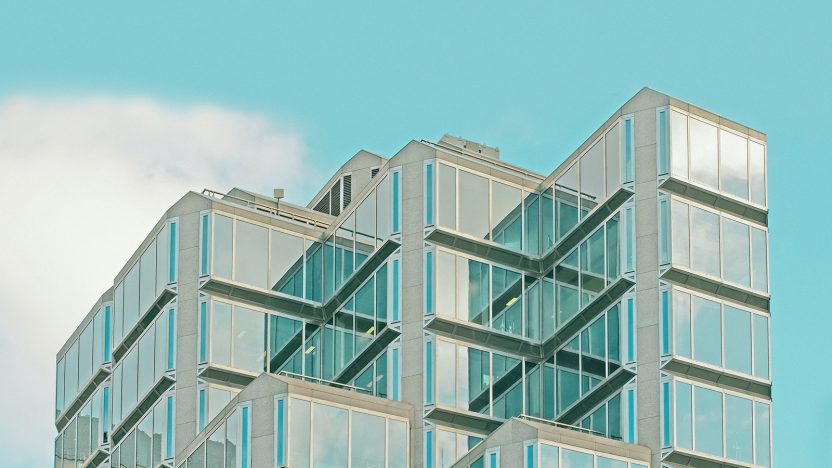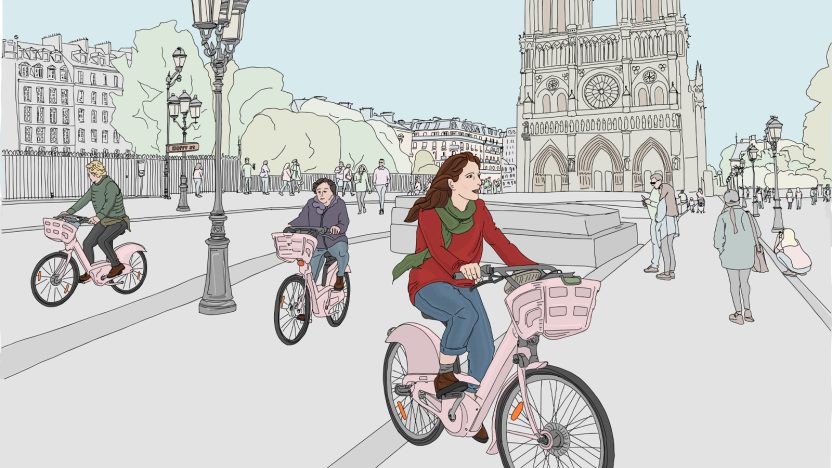Citizens’ aspirations in urban landscapes
The idea of “desire path” well exemplifies the relationship between the urban planner and citizens. What is the touch point between these two worlds?
In conversation with Carlo Ratti, by Luca Giacolini

Gaston Bachelard coined the term “desire path” in his 1958 book La Poétique de l’Éspace. It refers to the informal paths people create in urban landscapes to get from a starting point to a destination while avoiding existing paved roads. This phenomenon is a good example of the relationship between urban planners and citizens. On the one hand, city planners have aspirations and ambitions; on the other hand, city dwellers have their desires.
When do they match? And when do they clash? We explore this concept in an interview with Carlo Ratti, an Italian scientist and designer who directs the Senseable City Lab at the Massachusetts Institute of Technology and is a founding partner of CRA-Carlo Ratti Associati, a design and innovation practice. For the past two decades, his work has focused on how digital technologies are changing the way we understand, design, and ultimately live in cities. Ratti believes that resources should be shared and technology should be widely accessible.
Luca Giacolini: What does building a city mean today, and why is it a relevant topic to discuss in 2023? In a tweet, what does contemporary urban planning mean to Carlo Ratti?
Carlo Ratti: Cities at their best are spontaneous and unpredictable — not without a dose of mild chaos — making them the main driver of human innovation in their 10,000-year history. Today, urban planning is tasked with a seemingly impossible mission: to develop a framework that is clear enough to give cities a direction, in order to tackle our collective challenges (from the climate crisis to growing inequalities, to technologically-driven transformation) yet also being open enough to allow individuals to fill in the gaps and adapt the plan to their needs and desires. My dear friend and veteran sociologist Richard Sennett would say that this may ultimately be about “designing disorder.”

Illustrations by Giordano Poloni
LG: Over the past few decades, the role of architects in our society has changed dramatically, some might say, for the better. Can you point out the main highlights of this evolution?
CR: The most significant and necessary evolution for architects has been to move beyond the early 20th-century myth of the lone, heroic genius — people like Le Corbusier, Frank Lloyd Wright, or Mies van der Rohe. Today, there is still a danger of falling back into some of the absolutist ideas of the past — think of the many “starchitects” of the last couple of decades, whose work too often ignored the local context and celebrated formal prowess above all else. But I believe we should be moving in a different direction: embracing a more radical design agenda and pursuing a cross-disciplinary and collaborative approach while taking advantage of the new opportunities offered by the digital revolution.
LG: As an urban planner, what are your aspirations and desires when approaching a new urban masterplan project? How do you balance your creative vision with the social context you are designing for?
CR: The relationship between “design” and “desire” is complex. In both our research projects at MIT Senseable City Lab and our designs at CRA-Carlo Ratti Associati, data plays a critical role in this relationship, as it is precisely what allows us to move away from the misleading idea of the “hero architect” that I mentioned earlier. In the last few decades, we have witnessed the first stages of an unprecedented technological revolution in which we have all become producers of staggering amounts of data. Data is the byproduct of every action we take in the city.
By looking at the aggregated, anonymous information we collect, we can get a sense of how people move through space: where they go, what kind of people they meet, what they buy, and so on. In other words, data gives us perspective on how citizens experience the city. Taking this idea further, data gives us a picture — albeit a blurry one at first — of people’s varied desires. I believe data is a good starting point for achieving the balance you mentioned between creative vision and social context.
It’s exciting to think that you can wield data to gauge a collective sense of desire or even a longing for something that is absent, that isn’t yet there. Unexpressed desire is just as meaningful as expressed desire; as opposed to the Modernist approach of dismissing it, I think it is valid and needs to be taken into account.
Unexpressed desire is just as meaningful as expressed desire; as opposed to the Modernist approach of dismissing it, I think it is valid and needs to be taken into account.
LG: Connecting designers and communities is a crucial aspect of the design process. Can you give an example of how you “listen” to citizens and their behaviors, needs, and desires?
CR: Our practice is driven by a trans-disciplinary approach. We believe that involving as many stakeholders as possible in the design process will result in designs that better meet people’s desires. We did this with our Creative mediatorship for Manifesta 14, which took place last year in Pristina. The organizers of the Nomadic European Biennial asked us to develop an “urban vision” and some “urban interventions” to help reclaim the Kosovar capital’s public spaces, which have suffered for decades from the country’s tumultuous history.
To achieve this, we experimented with a public participation methodology we called “open-source architecture,” inspired by open-source and highly collaborative software projects. We applied this methodology in both high-tech and low-tech ways to cast a wide net for public desires and harness the potential of feedback. Our two-pronged open-source urbanism approach was instrumental in finding the right places for our actions.
On the high-tech side, we collected a lot of data by capturing photographic streetscapes and analyzing them with AI-powered algorithms. This gave us a better understanding of how people were using (or misusing) public space and precisely where it would make the most sense to intervene for maximum impact. On the low-tech side, we held ongoing conversations with people to understand their common desires, and developed dozens of different maps of the city and its social and geographic stratification.
This process resulted in a series of urban interventions that we promptly implemented using simple yellow paint or temporary urban furniture, to mark changes and reclaim public areas. Our objective was to make some temporary design actions to help Pristina’s citizens reimagine their streets and squares. Then we let citizens “vote with their feet,” acknowledging the act of showing up as a way to prove their interest, or their absence as a signal of disinterest.

LG: You often use the term “Senseable City” to describe a city capable of sensing its inhabitants’ needs and voices. What is the role of technology in designing a desirable city, and how can it support the role of the designer?
CR: Technology, for its own sake, is pointless (and a bit boring). That’s why I’ve never been a fan of the “smart city” label, which downplays the role of non-technological elements in urban life. Those urban developments that have focused on using technology to achieve efficiency as their ultimate goal, such as Songdo in South Korea or Masdar in the UAE, have turned out to be quite underwhelming and somehow miss the point of what makes urban life so exciting.
We prefer to talk about “Senseable Cities” to emphasize the social benefits of embedding digital technologies into our urban spaces. The word “senseable” implies both the sensitivity of digital technologies and the more human quality of being “sensible,” keeping people and their desires at the center. This quality has become increasingly urgent for cities as they address global challenges such as pandemics and climate change.
I believe that cross-disciplinary collaboration is essential to address these challenges. That’s why we advocate for a “choral architect,” not only to reject the notion of the all-knowing designer (which is simply untrue) but to highlight the need for an architect who is nimble and knowledgeable in many fields, able to coordinate and mobilize a wide range of stakeholders in a common symphony.
In your latest book, Urbanità, you take the reader with you on a journey through several cities around the world. In your opinion, which urban space best represents the idea of a desired community, and why?
CR: There’s no single answer to this question, but I’m very interested in how people relate to public space in the Nordic countries. In Finnish, it’s called jokamiehenoikeus, which literally means “everyman’s right,” and is also known as “the right to roam.” Fundamentally, everyone has the legal right to enjoy and move freely in any public space as long as it doesn’t harm people and nature. This is an expression of a recognized desire in urban space that is enshrined into law. Perhaps we could draw a line from that principle if we consider that many Nordic countries are also leading the way in terms of innovating urbanity to address the climate crisis.
One of CRA’s recent projects, the Helsinki Hot Heart (a winner of the Finnish capital’s Energy Challenge), leverages this enlightened Nordic sensibility to create a space that balances collective needs with individual desires. The challenge was to decarbonize Helsinki’s heating system. We achieved this by creating a large infrastructure for storing renewable energy that was not hidden or tucked away but made present in the public space. An archipelago of hot reservoirs floats in the gulf with a combination of new public spaces (including a tropical ecosystem) on its surface that people can roam and enjoy as they please.
LG: Looking to the future, what are your professional and personal desires for your next challenge and project as an architect and citizen?
CR: Our practice operates at the intersection of the natural and the artificial worlds, straddling both to address the complex urban challenges that lie ahead. As an architect and a citizen, I believe we should continue to innovate in urban planning. We should move beyond the twentieth-century idea that the urban-rural divide can be bridged by expanding the city outward. For example, the well-intentioned utopia of the “Garden City” unintentionally led to urban sprawl and land consumption.
Instead, I believe that in the twenty-first century, we should bring nature into the urban core and interweave it with urbanity in all possible aspects of the city: from new types of public spaces to urban farming, from using AI in the built environment, to circular architecture. As futuristic as this all may sound, I fundamentally share the desire expressed by the nineteenth-century French anarchist geographer Elysée Reclus.
He once wrote: “People must have the dual possibility of gaining access to the delights of the city, with its solidarity of thought and interest, its opportunities for study and art education, and, at the same time, the freedom that is nourished by nature and is realized through the varieties of its open horizons.”


